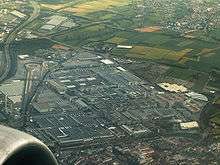Sindelfingen
| Sindelfingen | ||
|---|---|---|
|
St. Martin's church | ||
| ||
 Sindelfingen | ||
Location of Sindelfingen within Böblingen district 
 | ||
| Coordinates: 48°42′48″N 9°0′10″E / 48.71333°N 9.00278°ECoordinates: 48°42′48″N 9°0′10″E / 48.71333°N 9.00278°E | ||
| Country | Germany | |
| State | Baden-Württemberg | |
| Admin. region | Stuttgart | |
| District | Böblingen | |
| Government | ||
| • Mayor | Bernd Vöhringer | |
| Area | ||
| • Total | 50.85 km2 (19.63 sq mi) | |
| Population (2015-12-31)[1] | ||
| • Total | 63,971 | |
| • Density | 1,300/km2 (3,300/sq mi) | |
| Time zone | CET/CEST (UTC+1/+2) | |
| Postal codes | 71043–71069 | |
| Dialling codes | 07031 | |
| Vehicle registration | BB | |
| Website | www.sindelfingen.de | |
Sindelfingen is a German town near Stuttgart at the headwaters of the Schwippe (a tributary of the river Würm) that is the site of a Mercedes-Benz assembly plant.
History
- 1155 First documented mention of Sindelfingen
In 1263, Sindelfingen was founded by the Count Rudolf Scherer of Tübingen-Herrenberg.[2]
In 1351 the city was sold to Württemberg.[2]
- Middle Ages Notable weaving industry
- 1535 Entrance of the Protestant Reformation
- 1944 Stuttgart/Sindelfingen oil refinery bombed by the Oil Campaign of World War II
- 1958 Partnership with the French city Corbeil-Essonnes
- 1962 S. became "Große Kreisstadt"
- 1971 Maichingen and Darmsheim were incorporated
- 1987 Last Volksfest, a summer festival (the site was required for a county garden exhibition)
- 2013 Sindelfingen celebrated the 750 city founding anniversary[3]
The weaving industry survived until most of Europe's textile industry was wiped out due to Asian imports. Some textile distribution centres are still left in the town. Former weaving mills can still be found in the city area, now used as offices for the computer industry. This is due to the takeover of Hollerith by IBM which used the punched card technology from the weaving mills.
Geography
Neighbouring towns and cities: Böblingen (continuous), Stuttgart (15 km), Leonberg. The highest point is 531 metres above sea level and to the north is the Glemswald (Nature reserve).
Main sights


- Old city hall (Rathaus), now the city museum (free admission)
- St Martin's church (Martinskirche) (built: 11th–12th century)
- A short alley with half timbered houses (Fachwerkhäusern)
- Old cemetery (behind city library)
- Witch jump
- Cloister Lake
- Large public swimming pool with a long water slide [4]
- Water-tower on Goldberg
- Water-tower Sindelfingen-Steige
- Water-tower Sindelfingen-Eichholz
- Friendship Fountain on the market place, designed by Bonifatius Stirnberg.[5] Around a central fountain with the Pegasus are six small fountains representing the six partner towns of Sindelfingen. The figures can rotate.
- Miniature Railway in the Sommerhofen Park
- Powerline-branch Maichingen
- Zweigart-Sawitzki-Bridge
- High-based pylons
- TV repeater Darmsheim
- Transmitter Tower Fuchsberg
- Transmitter Tower service area Forest of Sindelfingen
- Daimler AG factory. Tours can be arranged through Mercedes dealers.
- Haus zur Geschichte der IBM Datenverarbeitung (IBM Dataprocessing History Museum)
Culture
Sindelfingen has an annual International Street Fair which features ethnic food and performances from the partner cities, as well as from various local ethnic clubs.
Demography
The resident counts below are either estimates, based upon census (*) or official records of respective statistical offices. All figures after 1871 are taken from the statistical office of Baden-Württemberg.[6]
|
|
Natives
- 1782, 30. April, Albert Schott, died 6. Juni 1861 in Stuttgart, jurist and politicianof the Frankfurt National Assembly
1921, 25. April, Karl Ganzhorn, died 25. August 2014 in Sindelfingen, physician, founder of IBM-Labor in Böblingen and member of board of IBM Germany
- 1948 Friederike Roth, author
- 1954 Erich Klemm, chairman of labour union of Daimler Benz
- 1967 Jörg Baldauf, Handicaped sportsman
- 1968 Bernd Vöhringer, politician (CDU), since 2001 Lord mayor of Sindelfingen
- 1968 Monika Henschel, musician, Henschel Quartett, (Viola)
- 1969 Christoph Henschel, musician(Violine), also Henschel Quartett
- 1971 Pascal Kober, parson and politician, Member of Bundestag
Carl Eytel (1862–1925), desert artist who immigrated to America in 1885 and eventually settled in Palm Springs, California
- Cubeatz, hip-hop production duo
- Roland Emmerich, (born 1955), German Film producer, director, and author
- Wizo is a Punk rock band from Sindelfingen
- Christoph, Markus & Monika Henschel, sibling musicians
Transport
Sindelfingen can be reached through the A8 and A81 motorways, and through the S-Bahn connections to Stuttgart or Herrenberg; the nearest airport is in Stuttgart.
Twin towns
Sindelfingen is twinned with:
 Schaffhausen, Switzerland, since 1952
Schaffhausen, Switzerland, since 1952 Corbeil-Essonnes, France, since 1961
Corbeil-Essonnes, France, since 1961 Sondrio, Italy, since 1962
Sondrio, Italy, since 1962 Dronfield, United Kingdom, since 1971
Dronfield, United Kingdom, since 1971 Győr, Hungary, since 1987
Győr, Hungary, since 1987 Torgau, Germany, since 1987
Torgau, Germany, since 1987 Chełm, Poland, since 2001
Chełm, Poland, since 2001- Sindelfingen is a member city of Eurotowns network[7]
References
- ↑ "Gemeinden in Deutschland nach Fläche, Bevölkerung und Postleitzahl am 30.09.2016". Statistisches Bundesamt (in German). 2016.
- 1 2 "Sindelfingen". Eurotowns. 2012-10-02. Retrieved 2015-03-08.
- ↑ "start" (in German). 750jahre.sindelfingen.de. 2014-08-01. Retrieved 2015-03-08.
- ↑ Archived 18 February 2005 at the Wayback Machine.
- ↑ Archived 9 April 2005 at the Wayback Machine.
- ↑ "Fläche, Bevölkerung - Statistisches Landesamt Baden-Württemberg". Statistik.baden-wuerttemberg.de. Retrieved 2015-03-08.
- ↑ "Eurotowns". Eurotowns. Retrieved 2015-03-08.
External links
-
 Sindelfingen travel guide from Wikivoyage
Sindelfingen travel guide from Wikivoyage

